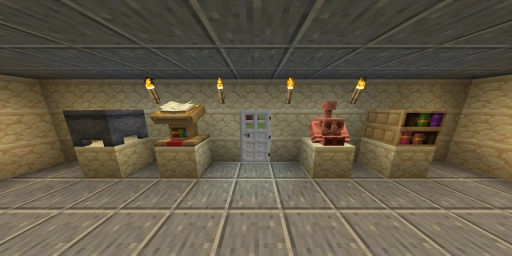Thanks to its Redstone mechanics, Minecraft offers countless ways to create clever puzzles. This works especially well with blocks and items that output different signal strengths. That way you can build complex systems that ultimately open doors or dispense rewards. On multiplayer servers, these contraptions are always a hit — you can hide your base, build a carnival, or even design a full escape room. Here’s how it works and which blocks are best suited for it.
Understand the Redstone Comparator: signals, modes, and door puzzles

To build Redstone puzzles, you need to know one component inside out: the Redstone Comparator. As the name suggests, it can compare and subtract signals and produce a new signal from them. Place it directly behind a block you want to read, or use it to redirect, block, or attenuate Redstone dust.
Its two modes are:
- Compare (light off): The comparator reads the state of the block in front of it (for example, how full a chest is). It also checks side inputs and only lets the front signal through if the side signal is equal to or weaker than the front.
- Subtract (light on): The comparator subtracts the side signal strength from the front signal. Example: Front 12, side 5 → output 7.
Helpful orientation:
- Input: The side with the two back torches (place the comparator facing away from the block you’re reading).
- Output: The side with the single small torch.
- Side inputs: Used for comparing and subtracting.
It can feel confusing at first — try different layouts and observe signal strengths with Redstone lamps.
10 ideas: doors, passwords, and puzzles with the Redstone Comparator
Comparators are extremely versatile and turn many block states into measurable signals. They read containers and special blocks — perfect for secret doors, number locks, and logic puzzles.

Lever combination lock: Like the Jungle Temple — with 3–4 levers, the solution stays fair. Use a side comparison to pass a signal only when the correct lever combination is set. Ideal as the entrance to a treasure room and great in combination with other riddles.
Lectern: A book on a lectern outputs a signal strength (1–15) based on the page. Hide clues in the world and make players find the correct page to open the door. Several lecterns in a row make a code-sequence lock.
Jukebox: Each music disc produces its own signal strength. Only when the right music is inserted does the door open. Perfect with hints like “Find the cheerful tune” or “The melody of the night.”

Chiseled Bookshelf: The comparator doesn’t read how full it is, but which slot (1–6) was used last. Place a specific book into the correct slot to produce the required signal — like the spy-movie trope where a book opens a secret passage.
Composter & Cauldron: Both output different signal strengths based on fill level (Composter: 0–8, Cauldron: 0–3 for water/powder snow). Use clues to make players deduce the correct fill level, then compare it with a comparator.
Item Frame: Each 45° rotation increases the signal by 1 (up to 8). Use multiple frames as a combination puzzle and compare the signals separately before you combine them.

Brewing Stand: The comparator detects how many potion bottles are in the stand (0–3). Create a puzzle where the door unlocks only when the correct number of potions is placed.
Cake: A whole cake outputs signal 14, and each bite reduces the strength by 2. Build a birthday puzzle: once the cake is eaten to a certain point, the surprise appears.
Bee Nest/Beehive: The honey level (0–5) can be read with a comparator. Combine it with a flower puzzle: only when the bees have produced enough honey can players proceed.
Chests, Barrels & Shulker Boxes: The comparator reads a container’s fill level (0–15). Require an exact item count as a password — e.g., “Place 23 emeralds in the chest” to open the secret door.
Pro tips for stable Redstone-comparator puzzles
- Isolate Redstone: Use repeaters or physical separation so side signals don’t interfere unintentionally.
- Normalize signals: With Redstone torches, repeaters, and comparators (in compare mode) you can build reliable, reproducible thresholds.
- Test and label: Mark inputs/sides on the comparator (input, output, side signals) and test each step with Redstone lamps.
Conclusion: puzzles, passwords, and doors with the Redstone Comparator
With Redstone comparators you can read and compare many states in Minecraft — perfect for door puzzles, password locks, and escape rooms. Use containers, special blocks, and smart logic to build creative, fair challenges.
It’s even more fun with friends! Rent one of our Minecraft servers (https://www.4netplayers.com/en-us/gameserver-hosting/minecraft/) and use comparators to create your own puzzles for others to solve.
More interesting articles
Introduction to Redstone: Understanding and Applying the Basics
Minecraft Automatic Door Mechanism: Simple Build with Redstone
Minecraft: Item Transport Systems With and Without Redstone
Minecraft Shelves: Storage, Redstone Tricks, and Hotbar Swaps




